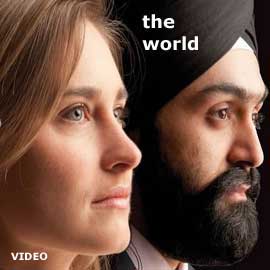
Above: detail from "Ninteen Eighty-Four", a painting by Rabindra and Amrita Kaur Singh. [Copyright: www.singhtwins.co.uk]
Books
Let Us Talk About Your Book:
Arvind Pal Singh Mandair - "Religion & The Specter of The West"
Part VIII
Q & A with Author by SIKHCHIC.COM
Q For the book cover, you chose Rabindra and Amrit Kaur Singh’s classic and iconic painting titled “Nineteen Eight-Four”? What relevance does it have for your book? What made you choose it?
A One of the themes that keeps coming up in Religion and the Specter of the West is that of trauma in relation to the Sikh subject.
The figure of trauma helps us to flesh out the normally subliminal violence of the colonial event in its various manifestations: the trauma of surrendering Sikh sovereignty to the British after 1849, followed by the trauma of dealing with an Indian nation state purporting to be ‘secular’, but constantly undermining Sikh attempts to govern themselves in post-1947 Punjab.
And, of course, the trauma of 1984 itself.
The affectivity of trauma associated with these events is discussed at various points in my book, and I think it is beautifully and violently captured in the Singh Twins’ mesmerizing portrayal of ‘1984’.
That’s essentially why I choose their artwork. The artwork also adorns the back wall of my office at the University of Michigan. Like myself, the Singh Twins are products of the diaspora and their hybridizing diasporic imagination can be seen in all of their artworks, and no less in the “1984” artwork.
The picture visually draws together past, present and future in a way that is reflected in the writing and composition style of my book (although what I weave together is not visual images, but ideas and concepts). The main difference in our visions, however, is in relation to what I believe is the central mark of the imperialism of the nation-state (in its Western and Indian guises) – namely the bondage of Sikhs and Sikhi to the repetition of the religion-secular binary.
I wasn’t aware of this difference until I read and responded to a superb critical review of my book, by the social anthropologist Michael Nijhawan.
Q What exactly did Nijhawan say?
A I think it's worth looking at what Nijhawan says in some detail. Here it is:
* * * * *
Mandair employs the notion of trauma to re-assess the “relation between language and response” for the “Indian” or “Sikh subject” (post/colonial subject in articular) for whom the self-naming in terms of religious categorizations of self and other (“I am a Sikh”) is read as a repetitive, traumatic re-insertion into the languagegames of “mono-theo-lingualism;” hence:
“This traumatic entry into the enunciation of religion, the response as religion, religion as the response is concomitant with a depoliticization of India and everything associated with it. Consequently “religion” does not constitute the same “reality” for a South Asian as it does for those who identify themselves with the formation called the West. Rather, the enunciation “religion” enjoins South Asians to hide the traumatic real and to instead identify with the fantasy of social reality created by nationalism”
The workings of such a logic can be illustrated when we pay closer attention to the artwork on the book cover, the Singh Twins’ painting “1984” that has been popularized in the press, various exhibitions, a self-made documentary by the artists, and which is now shown in a permanent exhibition at Washington, DC’s Smithsonian (“The Legacy of Punjab”).
We can read this piece of art and its investment in a heavily gendered, spectacular visibility of violence and suffering with its predominant frame of Sikh martyrdom within the “necrophilic tendency of the modern Sikh imaginary” that Mandair identifies as intellectuals and public figures have lamented the lack of public interest and engagement in reconciliation and commemoration efforts regarding the multiple losses of civilian life in 1984 and after.
And in particular the “1984” painting responds to the complaint that “the trauma experience” has found no appropriate memorials or monuments in Sikh art and literature …
There is a lot to say about the specific art genre here and the kind of transitions to be recovered when comparing the original small-scale work of the Singh Twins to the large scale work that was drawn some ten years later in the late 1990s …
If one can identify a strategic move from “trauma” to “unrepresentability” to “avant-garde” (performative) art in the contemporary art scene in general (at least as a tendency,) then “1984” stands somewhat opposed to those trends in its clinging to its event-centred, necrophilic regime of representation.
From the chosen bird’s-eye the viewer is granted a top-down view on the Darbar Sahib complex surrounded by the sarovar and the religious architectures built around it (distant suffering). With architectural designs and patterns portrayed in decorative detail on a flat, two-dimensional plane, arranged around the three-dimensional centre that stands out of the surrounding flatness, the artists provide signify the event as profoundly religious.
In its portrayal of agonized Sikh bodies, the painting arrests a particular historical moment of the 1984 attack on the temple complex by the Indian army. In its very style and by means of the artists’ choices and strategic omissions (e.g. no dead bodies of armed Sikh men to be seen), the image produces a religious subjectivity of suffering that is necessarily selective while generative of new and multiple interpretations and ways of seeing. Its original moment is formative in the sense of a particular orientation towards suffering expressed in the very act of art production.
Whereas in the caption of the painting, the artists write that the image expresses their own “mixed feeling” and the “personal sense of suffering and injustice felt by Sikhs worldwide,” it seems rather obvious that the significance of this work has to be sought beyond any such idiosyncratic framings.
In fact, the enthusiastic welcome of their artwork, not only by the Sikh diaspora, but also by British and North-American multicultural liberalism and related interfaith platforms, indicates a successful entry into precisely the translation regime through which Sikh suffering is universalized and written into dominant Western frameworks of conceptualizing collective suffering.
The Singh Twins’ contribution to the “Via Dolorosa” project, a British Christian-based, interfaith art project in which artists from a variety of faiths were invited to select and relate to one of the fifteen stations of the cross, testifies to the importance of the Judeo-Christian blueprint of suffering and martyrdom in these regards. In their short documentary, “1984 and the Via Dolorosa Project,” the two Sikh artists present two of the fifteen stations of the cross that they had chosen when asked to participate in the art project.
These are two videos that conflate a camera close-up moving and zooming on details of the painting with their own poetic verses that frame the 1984 events in metaphors of universal suffering hinging on the sacrifice of Christ.
Station One (“Jesus is condemned to die,” the scene where Pontius Pilate is seen symbolically washing his hands of blood) and Station Ten (“Jesus is stripped,” as the symbol for ultimate humiliation) that the artists chose for their contribution allow to highlight two key aspects which are identified as similar to the fate of Sikhs: the ignorance and deliberate miscarriage of justice at the hand of a central power (hence equated with the Indian government) and the stripping of the symbolically charged body as a form of ultimate humiliation and degradation.
The message is generally captured in the image of the “political manipulation of religion,” against which Sikhs are positioned in a gesture of fearless defence of the self and the religious neighbour (Hindu or Muslim). And in their poetic verses (recited along with the close-up shots of the image), Sikhism becomes the “faith in one God” that, like the other World Religions, has a “holy shrine” and a following of innocent devotees that are like “lambs” led to the “slaughterhouse” …
So predictably, it is the turn to a Christian theodicy that allows, as expressed in the representational regime of art (“1984”), completeness via the re-assertion of Sikhism entry into universal humanism.
[End of quote by Nijhawan]
Continued next week …
[The Nijhawan quote has been edited for sikhchic.com.]
March 10, 2014


